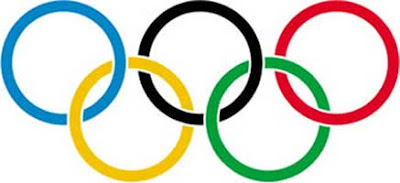
Desbordado por una semana repleta aunque quizá no tanto como la de los encargados de dar los últimos toques a la candidatura de Madrid para albergar los Juegos Olímpicos y Paralímpicos en el verano de 2016.
Mañana viernes, a las 19'00 aproximadamente se sabrá cuál de estas cuatro ciudades ha sido la elegida en Copenhague, donde se reúne el COI (Comité Olímpico Internacional).
Hasta que lo sepamos os dejo este video que hizo una estudiante de la universidad de Chicago para un trabajo de clase en mayo de 2008 sobre la candidatura de Madrid.
(Busy week, though perhaps not so busy as the week of the people in charge of putting the finishing touches to the Madrid bid to host the Olympic Games and Paralympic Games in summer 2016.
Tomorrow Friday, at about 19'00 we will know which of these four cities is the chosen one.
Until then I leave you this video by a Chicago university undergrad as part of a class project in May 2008 on the Madrid bid. )

Y, por cierto, ¿qué representan los anillos olímpicos?
Según el COI, la universalidad de los Juegos, basados en la idea de que al menos uno de los seis colores de la bandera olímpica está en todas las banderas de los países del mundo.
El símbolo se remonta a 1913 cuando Pierre de Coubertin (creador de los Juegos), en la Revue Olympique de agosto, informó del símbolo que sería usado para el Congreso Olímpico de París, en 1914: "cinco anillos entrelazados de diferentes colores (azul, amarillo, negro, verde y rojo), sobre el campo blanco del papel. Estos cinco anillos representan las cinco partes del mundo (las Américas, Europa, Asia, África y Oceanía) que se han unido al Olimpismo y que han aceptado competir sanamente."
(And, by the way, what do the Olympic rings represent?
According to the IOC, the universality of the Games, based on the idea that at least one of the six colours of the Olympic flag are in all the flags of the countries in the world.
The symbol dates back to 1913 when Pierre de Coubertin, in the Revue Olympique announced that the symbol that would be used for the Olympic World Congress in Paris in 1914 was: five intertwined rings in different colours (blue, yellow, black, green and red) on the white field of the paper. These five rings represent the five parts of the world (the Americas, Europe, Asia, Africa and Oceania) that have joined the Olympic Movement and that have agreed to compete healthily.")
Además, los seis colores combinados representan a todas las naciones sin excepción. El azul y el amarillo de Suecia; el azul y el blanco de Grecia; los tricolores mexicanos, franceses, británicos, estadounidenses, alemanes, belgas, italianos y húngaros; el amarillo y el rojo de España yacen junto a las banderas brasileñas y australianas y a las de Japón y China. Éste es, realmente, un emblema internacional.
(In addition, the six colours combined represent all nations without exception. The blue and yellow of Sweden, the blue and white of Greece, the tricolour Mexican, French, British, American, German, Belgian, Italian and Hungarian, the yellow and red of Spain lie next to the Brazilian and Australian flags and of Japan and China. This is really an international emblem.)
Bueno, la suerte está echada, así que ¡suerte a todos!
(Well, the die is cast, so the best of luck to all!)














No hay comentarios :
Publicar un comentario